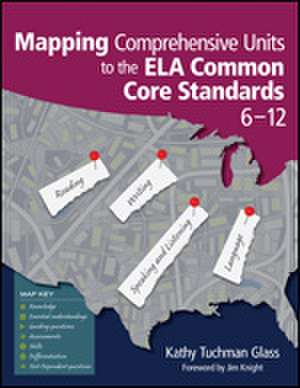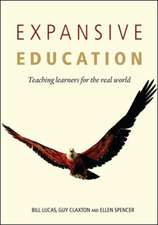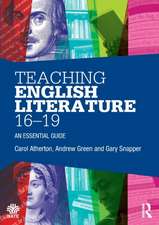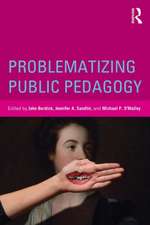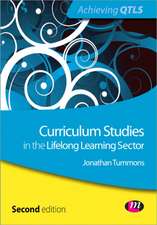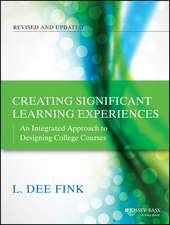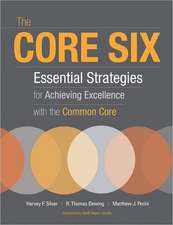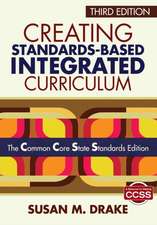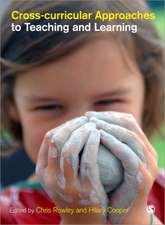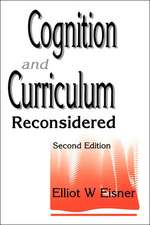Mapping Comprehensive Units to the ELA Common Core Standards, 6–12
Autor Kathy Tuchman Glassen Limba Engleză Paperback – 15 iul 2013
Preț: 330.81 lei
Nou
Puncte Express: 496
Preț estimativ în valută:
63.30€ • 66.39$ • 52.70£
63.30€ • 66.39$ • 52.70£
Carte tipărită la comandă
Livrare economică 01-15 aprilie
Preluare comenzi: 021 569.72.76
Specificații
ISBN-13: 9781452268620
ISBN-10: 1452268622
Pagini: 288
Dimensiuni: 216 x 279 x 18 mm
Greutate: 0.79 kg
Ediția:1
Editura: SAGE Publications
Colecția Corwin
Locul publicării:Thousand Oaks, United States
ISBN-10: 1452268622
Pagini: 288
Dimensiuni: 216 x 279 x 18 mm
Greutate: 0.79 kg
Ediția:1
Editura: SAGE Publications
Colecția Corwin
Locul publicării:Thousand Oaks, United States
Cuprins
List of Figures
Foreword
Acknowledgments
About the Author
Introduction
Chapter 1: Standards and Knowledge
The Purpose of Standards
Key Areas of Emphasis in the ELA Common Core Standards
Understanding Fiction and Nonfiction Characteristics
Definitions of the Common Core Text Types and Sample Prompts
What Do Argument Texts Entail?
What Do Informative/Explanatory Texts Entail?
What Do Narrative Texts Entail?
A Closer Look at Appendix C: Samples of Student Writing
Identifying and Articulating the Language Standards Across Grades
Exercise 1: What Is the Best Way to Group Standards?
Unit Focus and Template
Considerations for Grouping Standards
Grouping Standards: Two Approaches
Definition and Examples for Knowledge
Exercise 2: How Are Standards Used to Determine What Students Should Know?
Looking Ahead
Chapter 2: Essential Understandings
The Nature and Critical Importance of Essential (or Enduring) Understandings
Essential Understandings as Statements of Conceptual Intent
Examples of Essential Understandings Aligned to the Anchor Standards for Reading
Special Considerations: Time, Intellectual Growth, Clustering
Constructing Your Own Essential Understandings
Exercise 3: How Do Educators Create (or Revise) Essential Understandings?
Sharing Essential Understandings With Your Students
Looking Ahead
Chapter 3: Guiding Questions
The Importance of Guiding Questions
Sharing Guiding Questions With Your Students
The Differences Between Essential Unit and Lesson Guiding Questions
Designing Text-Dependent Questions for Complex Text
How Do Teachers Facilitate Close Reading of Complex Texts?
Examples of Essential Unit and Lesson Guiding Questions for Grammar and Conventions
Constructing Your Own Essential Unit and Lesson Guiding Questions
Exercise 4: How Do Educators Create (or Revise) Essential Unit and Lesson Guiding Questions?
Looking Ahead
Chapter 4: Unit Map Template and Example
Customizing and Adapting the Unit Map to Fit Your Needs
Organizing Unit Maps and Student Work
Looking Ahead
Chapter 5: Summative Assessments and Preassessments
Types of Assessments
Summative (Culminating) Assessments
Rubrics
Checklists
Preassessments
Constructing Your Own Summative Assessment
Exercise 5: How Do Educators Determine an Appropriate Summative Assessment?
Looking Ahead
Chapter 6: Skills, Activities, Formative Assessments, and Resources
Skills
Teaching Strategies and Learning Activities
Formative Assessments
Resources
Identifying Skills and Constructing Activities, Evidence of Assessment, and Resources for Your Targeted Unit
Exercise 6: What Targeted Skills With Associated Activities, Evidence of Assessment, and Resources Can Educators Design (and Find) for a Targeted Unit?
Looking Ahead
Chapter 7: Differentiated Instruction
Content, Process, and Product
Readiness, Learning Profile, and Interest
Instructional Strategy: Rolling Dice or Cubes
Instructional Strategy: Using Manipulatives
Constructing Your Own Differentiated Instructional Strategies
Exercise 7: How Can You Indicate Differentiation on Your Unit Map?
Looking Ahead
Chapter 8: Lesson Design
Lesson Components
Sample Lessons
Next Steps After Designing Lessons
A Final Note
Lesson 1: What Are Inferences? How Do I Make Inferences About This Text?
Lesson 2: What Is Characterization? How Do Authors Use Characterization to Create and Develop Characters?
Lesson 3: What Factors Help Me to Evaluate the Credibility of Sources?
Lesson 4: What Are Elements of an Argument Paper? What Are the Expectations for My Finished Argument?
Resource: A Brief Primer on the ELA Common Core Standards
Creation and Purpose of the Common Core Standards
Who Led the Standards Initiative, and What Is the Goal?
Who Are the CCSSO and NGA?
Content and Structure of the Common Core Standards
Research Highlights for the Reading Strand
Logistics
Can States Add to the Standards?
How Can Standards Be Identified?
Collaboration, Limitations, and Assessment
Who Uses These Standards Besides the ELA Teacher?
What Aspects Are Not Covered in the Common Core Standards Document?
What to Look for When Aligning Existing Standards With the Common Core
Assessments
Closing
References
Index
Foreword
Acknowledgments
About the Author
Introduction
Chapter 1: Standards and Knowledge
The Purpose of Standards
Key Areas of Emphasis in the ELA Common Core Standards
Understanding Fiction and Nonfiction Characteristics
Definitions of the Common Core Text Types and Sample Prompts
What Do Argument Texts Entail?
What Do Informative/Explanatory Texts Entail?
What Do Narrative Texts Entail?
A Closer Look at Appendix C: Samples of Student Writing
Identifying and Articulating the Language Standards Across Grades
Exercise 1: What Is the Best Way to Group Standards?
Unit Focus and Template
Considerations for Grouping Standards
Grouping Standards: Two Approaches
Definition and Examples for Knowledge
Exercise 2: How Are Standards Used to Determine What Students Should Know?
Looking Ahead
Chapter 2: Essential Understandings
The Nature and Critical Importance of Essential (or Enduring) Understandings
Essential Understandings as Statements of Conceptual Intent
Examples of Essential Understandings Aligned to the Anchor Standards for Reading
Special Considerations: Time, Intellectual Growth, Clustering
Constructing Your Own Essential Understandings
Exercise 3: How Do Educators Create (or Revise) Essential Understandings?
Sharing Essential Understandings With Your Students
Looking Ahead
Chapter 3: Guiding Questions
The Importance of Guiding Questions
Sharing Guiding Questions With Your Students
The Differences Between Essential Unit and Lesson Guiding Questions
Designing Text-Dependent Questions for Complex Text
How Do Teachers Facilitate Close Reading of Complex Texts?
Examples of Essential Unit and Lesson Guiding Questions for Grammar and Conventions
Constructing Your Own Essential Unit and Lesson Guiding Questions
Exercise 4: How Do Educators Create (or Revise) Essential Unit and Lesson Guiding Questions?
Looking Ahead
Chapter 4: Unit Map Template and Example
Customizing and Adapting the Unit Map to Fit Your Needs
Organizing Unit Maps and Student Work
Looking Ahead
Chapter 5: Summative Assessments and Preassessments
Types of Assessments
Summative (Culminating) Assessments
Rubrics
Checklists
Preassessments
Constructing Your Own Summative Assessment
Exercise 5: How Do Educators Determine an Appropriate Summative Assessment?
Looking Ahead
Chapter 6: Skills, Activities, Formative Assessments, and Resources
Skills
Teaching Strategies and Learning Activities
Formative Assessments
Resources
Identifying Skills and Constructing Activities, Evidence of Assessment, and Resources for Your Targeted Unit
Exercise 6: What Targeted Skills With Associated Activities, Evidence of Assessment, and Resources Can Educators Design (and Find) for a Targeted Unit?
Looking Ahead
Chapter 7: Differentiated Instruction
Content, Process, and Product
Readiness, Learning Profile, and Interest
Instructional Strategy: Rolling Dice or Cubes
Instructional Strategy: Using Manipulatives
Constructing Your Own Differentiated Instructional Strategies
Exercise 7: How Can You Indicate Differentiation on Your Unit Map?
Looking Ahead
Chapter 8: Lesson Design
Lesson Components
Sample Lessons
Next Steps After Designing Lessons
A Final Note
Lesson 1: What Are Inferences? How Do I Make Inferences About This Text?
Lesson 2: What Is Characterization? How Do Authors Use Characterization to Create and Develop Characters?
Lesson 3: What Factors Help Me to Evaluate the Credibility of Sources?
Lesson 4: What Are Elements of an Argument Paper? What Are the Expectations for My Finished Argument?
Resource: A Brief Primer on the ELA Common Core Standards
Creation and Purpose of the Common Core Standards
Who Led the Standards Initiative, and What Is the Goal?
Who Are the CCSSO and NGA?
Content and Structure of the Common Core Standards
Research Highlights for the Reading Strand
Logistics
Can States Add to the Standards?
How Can Standards Be Identified?
Collaboration, Limitations, and Assessment
Who Uses These Standards Besides the ELA Teacher?
What Aspects Are Not Covered in the Common Core Standards Document?
What to Look for When Aligning Existing Standards With the Common Core
Assessments
Closing
References
Index
Notă biografică
Descriere
This book offers a comprehensive plan for effective curriculum design that can be used as a model for either revising existing Grades 6-12 ELA curriculum or creating an entirely new one to meet the new Common Core ELA standards.
